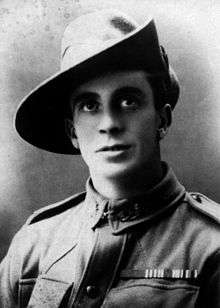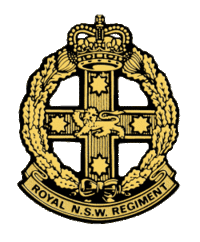41st Battalion, Royal New South Wales Regiment
| 41st Battalion, Royal New South Wales Regiment | |
|---|---|
|
Cap badge of the Royal New South Wales Regiment | |
| Active | 1965–present |
| Country |
|
| Branch | Australian Army |
| Type | Light Infantry |
| Size | Headquarters, Signals Platoon and two Rifle Companies |
| Part of | 8th Brigade, 2nd Division |
| Motto(s) | Mors Ante Pudorem (Death before Dishonour) |
| Colours | Black over Blue |
| March | Cock O'The North |
| Commanders | |
| Commanding Officer | Lieutenant Colonel Don Quinn |
| Insignia | |
| Unit Colour Patch |
|
The 41st Battalion, Royal New South Wales Regiment, (41 RNSWR), is an infantry battalion of the Australian Army. A Reserve unit, it is one of four battalions of the Royal New South Wales Regiment and is attached to the 8th Brigade, 2nd Division. It is based in northern New South Wales, with its headquarters in Lismore and depots in a number of locations including Tweed Heads, Taree, Grafton, Kempsey, Port Macquarie and Coffs Harbour.[1] In its present form the battalion was raised in 1965, however, it can trace its lineage back to a Scottish Rifles unit formed in 1899. It also perpetuates the battle honours and traditions of a battalion that served on the Western Front during the First World War.
History
41 RNSWR was formed in 1965 after the Australian Army ended its experiment with the Pentropic divisional structure which, in 1960, had seen the reorganisation of the previously existing regional Citizens Military Force (CMF) infantry battalions into company-sized elements within six new State-based regiments.[2] The experiment was a failure and by 1965, the Army returned to the triangular divisional structure and the CMF was reorganised once more. In an effort to reinvigorate the regional ties that had been so important to the CMF, the Pentropic battalions were reduced and new battalions formed by re-raising a number of their subordinate companies to battalion strength and re-adopting historical numerical designations.[3] As a part of this reorganisation, the Byron Scottish Company, which had been part of the 1st Battalion, Royal Queensland Regiment was expanded to form the 41st Battalion, Royal New South Wales Regiment,[4] headquartered around Lismore on the northern New South Wales coast.[3]

Drawing its lineage from the Byron Scottish Regiment, which had previously existed prior to the Pentropic restructure, 41 RNSWR's predecessor units can trace their history back to the Maclean Company Scottish Rifles which was formed in 1899.[5] This unit went through a number of name changes during its early history, eventually becoming the 9th Infantry in 1912. In 1918, it was amalgamated with the 12th (Byron) Infantry to form the 2nd Battalion, 41st Infantry after the Citizens Force was reorganised to form multi-battalion Regiments which were numbered after units of the Australian Imperial Force (AIF) with which they had been associated.[5]
In 1921, the decision was made to disband the AIF and to perpetuate its battle honours and traditions by reforming the Citizens Force along the same lines as the AIF, with the multi-battalion regiments being redesignated as separate battalions and adopting the unit colour patches and battle honours of the AIF. Consequently, the 2nd Battalion, 41st Infantry was redesignated as the 41st Battalion.[5]
During the First World War, this battalion had been formed in February 1916 at Bell's Paddock in Brisbane, Queensland, with men drawn from Queensland and northern New South Wales.[6] Attached to the 11th Brigade, 3rd Division, it took part in the fighting on the Western Front from November 1916 until the end of the war, during which time it took part in battles at Messines, Broodseinde, and Passchendaele in 1917. In early 1918, they took part in repulsing the German Spring Offensive, defending the railway near Amiens before taking part in the Allied Hundred Days Offensive which ultimately brought about an end to the war. The 41st Battalion's final involvement in the fighting came in early October when they took part in the joint Australian–US operation along the St Quentin Canal. It was out of the line resting when the armistice was signed in November 1918 and was disbanded in May 1919.[6] Losses during the war totalled 444 killed and 1,577 wounded.[6] One member of the battalion, Bernard Sidney Gordon, received the Victoria Cross.[7] Other decorations included: one CMG, two DSOs, 13 MCs and three bars, 12 DCMs, 82 MMs and two bars, four MSMs, 26 MIDs and seven foreign awards.[6]
In 1927, territorial designations were adopted and the battalion adopted the title 41st Battalion (The Byron Regiment). The motto Mors Ante Pudorem was also approved at this time.[8] In 1929, the compulsory training scheme was suspended by the Scullin Labor government, and this, combined with the economic hardships of the Great Depression led to a decline in the number of recruits. As a result, the battalion was amalgamated with the 2nd Battalion to form the 2nd/41st Battalion.[5] In 1933, these two units were delinked, however, the 41st Battalion was amalgamated with the 33rd Battalion to form the 33rd/41st Battalion. They remained linked until 1936 when tensions in Europe meant that the government decided to double the size of the Militia.[9]
During the Second World War, the battalion served in a garrison role within Australia and did not see active service overseas, even though it was gazetted as an AIF battalion after the majority of its members volunteered to do so. In 1943, when the Australian Army began reallocating manpower resources, the battalion was amalgamated once more with the 2nd Battalion, forming the 41st/2nd Battalion.[8] They remained linked until December 1945 when the demobilisation process began and the unit was disbanded.[5]
In 1948, the Citizens Military Force was re-raised, albeit on a limited scale.[10] The 41st Battalion was re-formed at this time, adopting the title 41st Infantry Battalion (The Byron Regiment), however, the following year its title was changed to The Byron Scottish Regiment. This remained the state of affairs until 1960, when the Pentropic divisional structure was introduced and the battalion became 'E' (Byron Scottish) Company, 1st Battalion, Royal Queensland Regiment.[5][8] The unit remained part of that regiment until being reformed as a full battalion within the Royal New South Wales Regiment after 1965.[4]
Recent roles
Recently 41 RNSWR has had a number of operational roles. These roles have included providing soldiers to the serve with INTERFET in East Timor and with the Peace Monitoring Groups in Bougainville. In 2000, they took part in providing security to the Sydney Olympic Games through the Operational Search Battalion. Personnel from the battalion have also deployed as part of commitments to the Solomon Islands as part of the Regional Assistance Mission to Solomon Islands (RAMSI) and Malaysia with Rifle Company Butterworth.[11] In 2011, members of the battalion served in East Timor as part of the Timor Leste Task Group (TLTG).[12]
Kilted tradition
Due to its lineage from the Byron Scottish Regiment, 41 RNSWR retains an entitlement to wear a kilt. The battalion was formerly known as the 41st Battalion, The Byron Scottish Regiment.[5] This is due to the large number of Scots who settled in the north of the state in areas such as Grafton, Byron Bay and Maclean.[11] 41 RNSWR maintains an alliance with the Argyll and Sutherland Highlanders and personnel from the battalion's Grafton depot may wear the kilt of the Argyll and Sutherland Highlanders on ceremonial occasions.[13]
Unit motto
"Mors Ante Pudorem" which means "Death before Dishonour". This motto was adopted by 41 RNSWR because since its formation in 1916 none of its personnel have been captured in battle.[11]
Locations
41 RNSWR is located all along the northern New South Wales coast, including depots in:
- Tweed Heads: (1 Platoon, 3 Platoon and Headquarters 'A' Company)
- Lismore: (Battalion Headquarters, Admin Company, 2 Platoon 'A' Company)
- Grafton: (8 Platoon 'C' Company)
- Coffs Harbour: (Headquarters 'C' Company, 7 Platoon)
- Kempsey: (12 Platoon 'D' Company)
- Port Macquarie (11 Platoon and Headquarters 'D' Company)
- Taree
Victoria Cross recipients
- Lance Corporal Bernard Sidney Gordon, 41st Battalion, 11th Brigade, 3rd Division:
For most conspicuous bravery and devotion to duty on 26–27 August 1918, east of Bray. He led his section through heavy shell-fire to the objective which he consolidated. Single-handed he attacked an enemy machine-gun which was enfilading, the company on his right, killed the men on the gun and captured the post, which contained one officer and ten men. He then cleaned up a trench, capturing twenty-nine prisoners and two machine-guns. In cleaning up further trenches he captured twenty-two prisoners, including one officer, and three machine-guns. Practically unaided, he captured, in the course of these operations, two officers and sixty-one other ranks, together with six machine-guns, and displayed throughout a wonderful example of fearless initiative.[7]
Notes
- ↑ "8 Bde Units". Department of Defence. Archived from the original on 24 April 2010. Retrieved 21 February 2010.
- ↑ Grey 2008, p. 228
- 1 2 Grey 2008, p. 239
- 1 2 Shaw 2010, pp. 10–11
- 1 2 3 4 5 6 7 Harris, Ted. "Lineage of the Royal New South Wales Regiment". Digger History.org. Archived from the original on 19 May 2009. Retrieved 15 May 2009.
- 1 2 3 4 "41st Battalion". First World War, 1914–1918 units. Australian War Memorial. Retrieved 21 February 2010.
- 1 2 The London Gazette: (Supplement) no. 31082. p. 15118. 24 December 1918. Retrieved 21 February 2010.
- 1 2 3 Festberg 1972, p. 99
- ↑ Keogh 1965, p. 45
- ↑ Grey 2008, p. 200
- 1 2 3 Harris, Ted. "41 RNSWR". Digger History.org. Archived from the original on 21 February 2010. Retrieved 21 February 2010.
- ↑ Manley, Mairi (15 June 2012). "Celebrating safe return from Timor". My Daily News. Retrieved 22 April 2014.
- ↑ "The Argylls: Allied Regiments, Volunteers and Militia". About Scotland. Retrieved 21 February 2010.
References
- Festberg, Alfred (1972). The Lineage of the Australian Army. Melbourne, Victoria: Allara Publishing. ISBN 978-0-85887-024-6.
- Grey, Jeffrey (2008). A Military History of Australia (3rd ed.). Melbourne: Cambridge University Press. ISBN 978-0-521-69791-0.
- Keogh, Eustace (1965). South West Pacific 1941–45. Melbourne: Grayflower Publications. OCLC 7185705.
- Shaw, Peter (2010). "The Evolution of the Infantry State Regiment System in the Army Reserve". Sabretache. Garran, Australian Capital Territory: Military Historical Society of Australia. LI (4 (December)): 5–12. ISSN 0048-8933.
